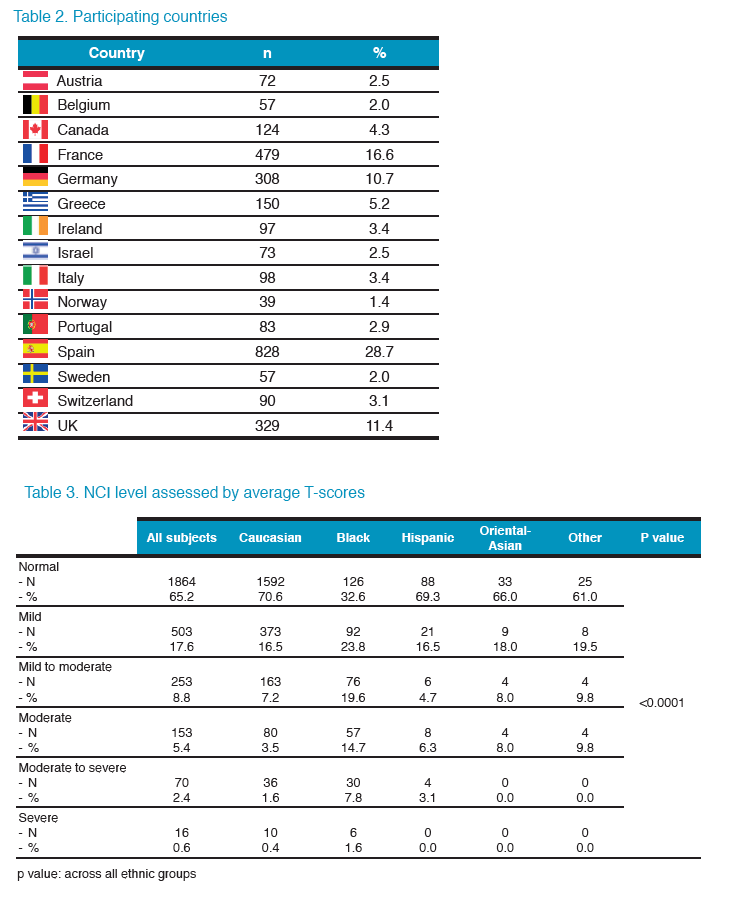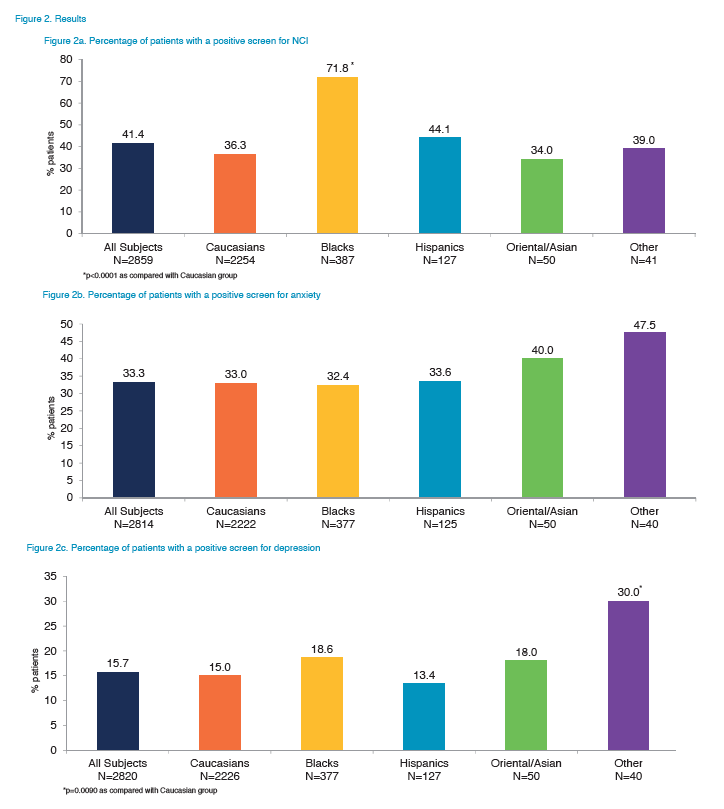| |
Neurocognitive Impairment (NCI), Depression, and Anxiety in HIV-1 Infected Patients Across Western Europe and Canada, The CRANIum Study- Ethnicity analysis (Glasgow 11/2012)
|
| |
| |
Reported by Jules Levin
Eleventh International Congress on Drug Therapy in HIV Infection,
11-15 November 2012, Glasgow
----------------------------------------
The Prevalence of a Positive Screen for Neurocognitive Impairment and Anxiety/Depression in HIV-1 Infected Patients Across Western Europe and Canada - The CRANIum Study: Age Analysis
Reported by Jules Levin
3rd International Workshop on HIV & Aging. 5-6 November, 2012. Baltimore, MD,
USA.
http://www.natap.org/2012/AGE/AGE_12.htm
----------------------------------------
Daniel Elbirt1, Carmen Bayon2, Kevin Robertson3, Helen Sambatakou4, Patricia McNamara5, Ranjababu Kulasegaram6, Gabriel Schembri7, Cristina de Alvaro8, Esther Cabrero8, Matt Guion9, Michael Norton9, Olivier van de Steen10, Jean van Wyk 10 1) Neve Or AIDS center, Kaplan MC Rehovot, Israel; 2) Hospital La Paz, IdiPaz, Madrid, Spain; 3) University of North Carolina, Chapel Hill, North Carolina, USA; 4) Hippokration General Hospital, Athens, Greece; 5) St. James’s Hospital, Dublin, Ireland; 6) Guy’s and St Thomas’ NHS Foundation Trust, London, UK; 7) Manchester Royal Infirmary, Manchester, UK; 8) Abbott Laboratories, Madrid, Spain; 9) Abbott Laboratories, Chicago, Illinois, USA; 10) Abbott Laboratories, Paris, France
From Jules: this “large epidemiology” study conducted in Western Europe mainly reported 41% of patients with a positive screen for NCI, 33% with anxiety, and 15.7% with depression.
CONCLUSIONS
· The overall prevalence of a positive screen for NCI was high in this large epidemiologic study. In particular, the rate of NCI in Black patients was nearly double that of the overall study population. This finding needs to be interpreted in light of differences in demographics and disease characteristics between ethnic groups.
· The overall prevalence of a positive screen for depression in our sample was nearly double what has previously been reported in the non-HIV infected population in Europe (8.56%) when utilizing a similar screening tool22, with no significant differences between classifiable ethnic groups.
· These results support a strategy of regular screening for, and clinical management of NCI, depression, and anxiety in all HIV-infected patients, with specific focus on NCI in the Black population.
Limitations
· CRANIum was a cross-sectional, epidemiology study without prospective follow-up data. As such, interpretation of the predictive associations between risk factors and outcomes remain difficult and do not demonstrate causality.
· The small number of patients in some of the ethnic groups needs to be considered when interpreting the results.
· The BNCS battery includes tests that evaluate only three cognitive domains (speed of information processing, attention/working memory and executive functioning). Although these tests have been found to be sensitive in detecting HIV-related neurocognitive changes23, this brief battery is used as a screening tool only and is not validated for independent diagnosis of NCI in an HIV population.
· The normative data used for the BNCS are based on gender, age, education and ethnicity adjusted United States norms and do not account for potential variation and may not be widely applicable across other countries in this study. Birth country or nationality was not recorded in the demographics.
· The study utilized a screening tool, and not structured or semi-structured diagnostic interviews for the diagnosis of depression and anxiety disorders. The use of interviews would offer superior reliability and validity, increasing the quality of the study.
BACKGROUND
· In Human Immunodeficiency Virus (HIV)-infected individuals in the Highly Active Antiretroviral Therapy (HAART) era, a significant decrease in the incidence of HIV-associated dementia has been reported. However, the prevalence of less severe forms of cognitive impairment has increased, with ranges from 20% to 50%, depending of the neurocognitive tools and definitions used, and is consistently higher than in the general population1-3. HIV infected individuals suffering from mild cognitive impairment may have an increased risk of dementia and death 4,5.
· The prevalence of depressive symptoms in HIV infected individuals has been reported as between 12-71%6-10, with up to 50% of these individuals experiencing a major depressive disorder11. The presence of depressive symptoms in HIV infected individuals has been associated with decreased adherence to ART, more rapid discontinuation of ART, decreased quality of life (QoL) and increased risk of substance abuse12-14.
· Previous presentations of the CRANIum study reported that 41.5% of patients had a positive screen for NCI15, 15.7% of patients had a positive screen for depression, and 33.3% of patients had a positive screen for anxiety16.
OBJECTIVE
· The primary objective of the CRANIum study was to describe and compare the prevalence of a positive screening for NCI, depression, and anxiety in an HIV-1 infected population on HAART versus HAART-naïve patients.
· Here we present the ethnicity analysis of the CRANIum study.
METHODS
Study Design
· CRANIum was a multinational, multicenter, cross-sectional epidemiology study, conducted from October 2010 to June 2011 across Western Europe and Canada, using validated screening tools in an HIV-infected population.
· We aimed to include approximately one third HAART-naïve patients, one third ritonavir-boosted Protease Inhibitor (PI/r) treated patients and one third Non-Nucleoside Reverse Transcriptase Inhibitor (NNRTI) treated patients. In addition, an a priori recruitment target of at least 40% female subjects was set.
Screening Tools
· The Brief Neurocognitive Screen (BNCS) consists of three tests: Digit Symbol (DS) Test, Trail Making Test - Part A (TMT-A) and Trail Making Test - Part B (TMT-B)17-19. A positive screen for NCI was defined as one standard deviation (SD) below the population mean on two tests or two SD below the population mean on one test.
· Impairment level was additionally assessed by pre-defined categories utilizing average T-scores (classified from normal to severe impairment).
· The Hospital Anxiety and Depression Scale (HADS) was used to screen for anxiety (HADS-A) and depression (HADS-D). HADS is self-administered and consists of 14 items (7 HADS-A, 7 HADS-D) scored between 0 to 320. A total score of ≥8 was considered as a positive screen for either condition21.
Study Population
Main inclusion criteria:
· Male and female HIV-1 infected patients aged ≥ 18 years, attending a routine medical follow-up visit.
· For patients on HAART, stable PI/r or NNRTI-based regimen for at least 9 months before participating in the study.
· Able to complete screening tools.
Main exclusion criteria:
· For antiretroviral (ARV)-naïve patients, use of ARVs during the previous 6 months or > 4 weeks in their lifetime.
· Current/active central nervous system (CNS) opportunistic infections or CNS malignancies; previous stroke or history of transient ischemic attacks, or neuromuscular disease that could affect a patient’s ability to perform the screening tests.




· When comparing ARV-naive to -experienced patients within ethnic groups, there were no significant differences except for a higher prevalence of a positive screen for NCI in ARV-experienced patients in the Black group (75.3% vs 62.5%; p=0.0133), and a higher prevalence of a positive screen for depression in ARV-experienced patients in the Caucasian group (16.6% vs 11.6%; p=0.0019).
In multivariate analyses:
· Female gender, black race, single marital status, unemployed or student, time from HIV diagnosis <5 years, no alcohol use or an ex-drinker, no hepatitis B or C co- infection, a positive screen for depression, and a last recorded CD4+ T-cell count lower than 350 cells/μL were associated with a positive screen for NCI.
· No alcohol use or being an ex-drinker, being unemployed or a student, a previous psychiatric diagnosis, having any documented drug resistance, a previous CNS infection, a positive screen for NCI, and utilization of psychiatric services in the previous 12 months were associated with a positive screen for depressive symptoms.
· No alcohol use or being an ex-drinker, being unemployed or a student, living in a large town or city, previous psychiatric diagnoses, smoking, use of illegal substances/narcotics in the previous 12 months, and utilization of psychiatric services in the previous 12 months were associated with a positive screen for anxiety.
References
1. Robertson KR, et al. AIDS 2007; 21: 1915-21. 2. Heaton RK, et al. Neurology 2010; 75: 2087-96. 3. Gandhi NS, et al. J Neurovirol 2011; 17: 159-65. 4. Del Palacio M, et al. Rev Med Viro. 2012; 22: 33-45. 5. Sevigny JJ, et al. Arch Neurol 2007; 64: 97-102. 6. Heckman et al. AIDS & Behaviour 2007; 11 (1): 5-14. 7. Mulder et al. Psychosomatic Medicine 1994; 56 (5): 423-31. 8. Balfour et al. AIDS Care 2006; 18 (7): 830-38. 9. Smith Fawzy et al. HIV Medicine 2007; 8 (4): 203-12. 10. Sarna et al. JAIDS 2008; 48 (5): 611-19. 11. Ciesla et al. Am J Psychiatry 2001; 158 (5): 725-30. 12. Selnes et al. JAIDS 2002; 31 (Suppl 5): S132-S135. 13. Bangsberg et al. 41st ICAAC 2001. Chicago, USA. #1721. 14. Wisniewskie et al. J Neurovirol 2005; 11 (2): 138-43. 15. Robertson et al. 19th International AIDS Conference 2012. Washington DC, USA. #TUPE155. 16. Bayon C, et al. 19th Conference on Retroviruses and Opportunistic Infections, 2012. Seattle, Washington. P503. 17. Reitan RM, Wolfson D. Neuropsychology Press 1985. 18. Wechsler D. The Psychological Corporation 1981. 19. Ellis RJ, et al. J Neurovirol 2005; 11:503-11. 20. Savard et al. J Pers Assess 1998; 71 (3):349-67. 21. Zigmond AS, et al. Acta Psychiatr Scand 1983; 67 (6): 361-70. 22. Ayuso-Mateos et al. BJP 2001; 179: 308-16. 23. Ellis RJ, et al. J Neurovirol 2005; 11:503-11.
| |
| |
| |
|
|
|